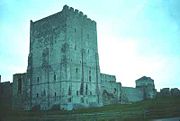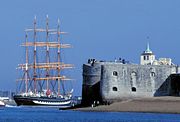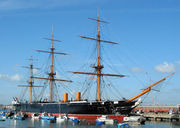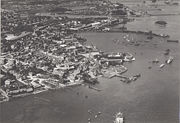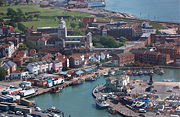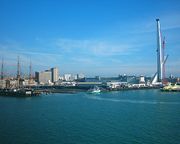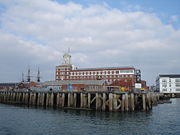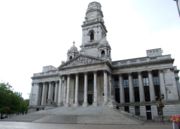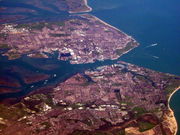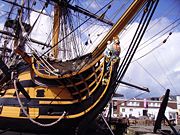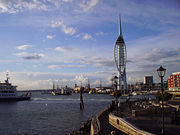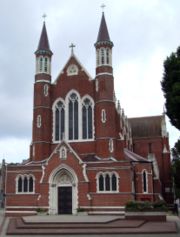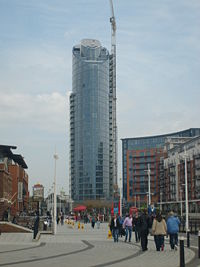Portsmouth
2008/9 Schools Wikipedia Selection. Related subjects: British Cities; Great Britain
| City of Portsmouth | |
|---|---|
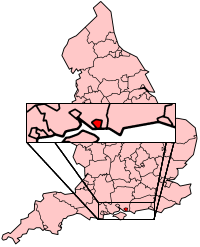 |
|
| Geography | |
| Status | Unitary, City (1926) |
| Region | South East England |
| Ceremonial County | Hampshire |
| Area - Total |
Ranked 319th 40.25 km² |
| Admin. HQ | Portsmouth |
| ONS code | 00MR |
| Demographics | |
| Population - Total (2006 est.) - Density |
Ranked 71st 196,400 4880 / km² |
| Ethnicity | 91.9% White 3.4% S.Asian 1.1% Black 1.2% Mixed Race 2.4% Chinese or Other |
| Politics | |
 Portsmouth City Council http://www.portsmouth.gov.uk/ |
|
| Leadership | Leader & Cabinet |
| Executive | TBA (council NOC) |
| MPs | Mike Hancock (LD) Sarah McCarthy-Fry ( Lab/Co-op) |
Portsmouth ( /ˈpɔːtsməθ/ ) is a city located in the county of Hampshire on the southern coast of England, and is the UK's only island city. It is commonly nicknamed Pompey. The administrative unit itself forms part of the wider Portsmouth conurbation, with an estimated 442,252 residents within its boundaries, making it the 11th largest urban area in England. At the 2001 census it was the only city in England with a greater population density (4,639 /km² (12,015 /sq mi)) than London as a whole (4,562/km² (11,816/sq mi)), although many of London's individual boroughs had a much greater density.
A significant naval port for centuries, Portsmouth is home to the world's oldest dry dock still in use and home to many famous ships, which includes Nelson's famous flagship HMS Victory. Portsmouth has declined as a naval base in recent years but remains a major dockyard and base for the Royal Navy. There is also a commercial port serving destinations on the continent for freight and passenger traffic.
The Spinnaker Tower is a recent addition to the city's skyline. It can be found in the recently redeveloped area known as Gunwharf Quays.
The Portsmouth Urban Area covers an area with a population well over twice that of the city of Portsmouth itself, and includes Fareham, Portchester, Gosport, Havant (which includes the large suburbs of Leigh Park), Lee-on-the-Solent, Stubbington and Waterlooville.
The suburbs of Portsmouth and Southampton to the west arguably form a conurbation stretching from Southampton to Havant on the M27/ A27 road along the coast, and north to Clanfield on the A3 road.
History
There have been settlements in the area since before Roman times, mostly being offshoots of Portchester, which was a Roman base ( Portus Adurni) and possible home of the Classis Britannica. Portsmouth is commonly regarded as having been founded in 1180 by John of Gisors ( Jean de Gisors). Most early records of Portsmouth are thought to have been destroyed by Norman invaders following the Norman Conquest. The earliest detailed references to Portsmouth can be found in the Southwick Cartularies. However, there are records of "Portesmūða" from the late 9th century, meaning "mouth of the Portus harbour".
The Anglo-Saxon Chronicle entry for 501 claims that "Portesmuða" was founded by a Saxon warrior called Port, though historians do not accept that origin of the name. The Chronicle states that:
"Her cwom Port on Bretene 7 his .ii. suna Bieda 7 Mægla mid .ii. scipum on þære stowe þe is gecueden Portesmuþa 7 ofslogon anne giongne brettiscmonnan, swiþe æþelne monnan."
The battle is attested in early Welsh sources as the Battle of Llongborth. The poem names the Chronicle’s "young British man of nobility" as Geraint map Erbin.
In the Domesday Book there is no mention of Portsmouth. However, settlements that later went on to form part of Portsmouth are listed. At this time it is estimated the Portsmouth area had a population not greater than two or three hundred. While in Portsea there was a small church prior to 1166, Portsmouth's first real church came into being in 1181 when a chapel dedicated to Thomas Becket was built by Augustinian monks and run by the monks of Southwick Priory until the Reformation. The modern Portsmouth Anglican Cathedral is built on the original location of the chapel.
In 1194 King Richard The Lionheart returned from being held captive in Austria, and set about summoning a fleet and an army to Portsmouth, which Richard had taken over from John of Gisors. On May 2, 1194 the King gave Portsmouth its first Royal Charter granting permission for the borough to hold a fifteen day annual "Free Market Fair", weekly markets, to set up a local court to deal with minor matters, and exemption from paying the annual tax, with the money instead used for local matters. King Richard later went on to build a number of houses and a hall in Portsmouth. The hall is thought to have been at the current location of the Clarence Barracks (the area was previously known as Kingshall Green). It is believed that the crescent and eight-point star found on the thirteenth century common seal of the borough was derived from the arms of William de Longchamp, Lord Chancellor to Richard I at the time of the granting of the charter. The crescent and star, in gold on a blue shield, were subsequently recorded by the College of Arms as the coat of arms of the borough.
In 1200 King John reaffirmed the rights and privileges awarded by King Richard. King John's desire to invade Normandy resulted in the establishment of Portsmouth as a permanent naval base, and soon after construction began on the first docks, and the Hospital of St Nicholas, which performed its duties as an almshouse and hospice. During the thirteenth century Portsmouth was commonly used by King Henry III and Edward I as a base for attacks against France.
By the fourteenth century commercial interests had grown considerably, despite rivalry with the dockyard of nearby Southampton. Common imports included wool, grain, wheat, woad, wax and iron, however the port's largest trade was in wine from Bayonne and Bordeaux.
In 1338 a French fleet led by Nicholas Béhuchet raided Portsmouth, destroying much of the town, with only the local church and hospital surviving. Edward III gave the town exemption from national taxes to aid reconstruction. Only ten years after this devastation the town for the first time was struck by the Black Death. In order to prevent the regrowth of Portsmouth as a threat, the French again sacked the city in 1369, 1377 and 1380. Henry V was the first to build permanent fortifications in Portsmouth. In 1418 he ordered a wooden Round Tower be built at the mouth of the harbour, which was completed in 1426. King Henry VIII rebuilt the fortifications with stone, raised a square tower, and assisted Robert Brygandine and Sir Reginald Bray in the construction of the country's first dry dock. In 1527, with some of the money from the dissolution of the monasteries, Henry VIII built Southsea Castle. In 1545, he saw his vice- flagship Mary Rose founder off Southsea Castle, with a loss of about 500 lives, while going into action against the French fleet. Over the years Portsmouth's fortification was increased by numerous monarchs, although most of these have now been converted into tourist attractions.
Portsmouth has a long history of supporting the Royal Navy logistically, leading to it being important in the development of the Industrial Revolution. Marc Isambard Brunel, the father of famed Portsmouth engineer Isambard Kingdom Brunel, established in 1802 the world's first mass production line at the Portsmouth Block Mills, to mass produce pulley blocks for rigging on the Royal Navy's ships. At its height the Dockyard was the largest industrial site in the world.
Admiral Nelson left Portsmouth for the final time in 1805 to command the fleet that would defeat the larger Franco-Spanish fleet at Trafalgar. The Royal Navy's reliance on Portsmouth led to the city becoming the most fortified in Europe, with a network of forts circling the city. From 1808 the Royal Navy's West Africa Squadron, who were tasked to stop the slave trade, operated out of Portsmouth. On December 21, 1872 a major scientific expedition, the Challenger Expedition, was launched from Portsmouth.
In 1916 the town experienced its first aerial bombardment when a Zeppelin airship bombed it during World War I.
In 1926 Portsmouth was granted city status, following a long campaign by the borough council. The application was made on the grounds that Portsmouth was the "first naval port of the kingdom". Two years later the city received the further honour of a lord mayoralty. In 1929 the city council added the motto "Heaven's Light Our Guide" to the medieval coat of arms. Apart from referring to the celestial objects in the arms, the motto was that of the Star of India. This recalled that troopships bound for the colony left from the port. Further changes were made to the arms in 1970, when the Portsmouth Museums Trust sponsored the grant of crest, supporters and heraldic badge. The crest and supporters are based on those of the royal arms, but altered to show the city's maritime connections: the lions and unicorn have been given fish tails, and a naval crown placed around the latter animal. Around the unicorn is wrapped representation of "The Mighty Chain of Iron", a Tudor defensive boom across Portsmouth Harbour.
The city was bombed extensively during World War II, destroying many houses and the Guildhall. While most of the city has since been rebuilt, developers still occasionally find unexploded bombs. Southsea beach and Portsmouth Harbour were military embarkation points for the D-Day landings on June 6 1944. Southwick House, just to the north of Portsmouth, had been chosen as the headquarters for the Supreme Allied Commander, US General Dwight D. Eisenhower, during D-Day.
After the war, much of the city's housing stock was damaged and more was cleared in an attempt to improve the quality of housing. Those people affected by this were moved out from the centre of the city to new developments such as Paulsgrove and Leigh Park. Post-war redevelopment throughout the country was characterised by utilitarian and brutalist architecture, with Portsmouth's Tricorn Centre one of the most famous examples. More recently, a new wave of redevelopment has seen Tricorn's demolition, the renewal of derelict industrial sites, and construction of the Spinnaker Tower.

Economy
This is a chart of trend of regional gross value added of Portsmouth at current basic prices published (pp.240-253) by Office for National Statistics with figures in millions of British Pounds Sterling.
| Year | Regional Gross Value Added | Agriculture | Industry | Services |
|---|---|---|---|---|
| 1995 | 2,023 | - | 496 | 1,528 |
| 2000 | 2,750 | - | 658 | 2,092 |
| 2003 | 3,362 | - | 705 | 2,657 |
- Note 1. includes hunting and forestry
- Note 2. includes energy and construction
- Note 3. includes financial intermediation services indirectly measured
- Note 4. Components may not sum to totals due to rounding
- Note 2. includes energy and construction
A tenth of the city's workforce works at Portsmouth Naval Dockyard, which is directly linked to the city's biggest industry, defence, with major sites for BAE and VT Group located in the city. VT have been awarded some of the construction work on the two new Royal Navy aircraft carriers, although this involved the merger with BAe ship group. This will create 3000 new jobs in the city. There is also a major ferry port which deals with both passengers and cargo. The city is also host to the European headquarters of IBM, and the UK headquarters of Zurich Financial Services.
In the last decade the number of shops in Portsmouth has grown dramatically due to both the buoyancy of the local economy and improved transport links. In the city centre, shopping is centred around Commercial Road and the 1980s Cascades Shopping Centre, with over 100 high street shops between them. Recent redevelopment have created new shopping areas, including the upmarket Gunwharf Quays, containing fashion stores, restaurants, and a cinema; and the Historic Dockyard, which aims at the tourist sector and holds regular French markets, and an annual Christmas market. Large shopping areas include Ocean Retail Park, on the north-eastern side of Portsea Island, composed of shops requiring large floor space for selling consumer goods; and the Bridge Centre an 11,043 square metre shopping centre built in 1988, now dominated by the Asda Walmart store. There are also many smaller shopping areas throughout the city.
There is a small fishing fleet based in the city.
Tourism is also a growing sector of the economy.
The housing boom has also spurned economic growth with prices rising at a speed second only to London.
Government and politics
The city is administered by Portsmouth City Council, which is currently a unitary authority. Portsmouth was granted its first charter in 1194. In 1904 the boundaries were extended to finally include the whole of Portsea Island. The boundaries were further extended in 1920 and 1932, taking in areas of the mainland. Until April 1, 1997 it was a non-metropolitan district of Hampshire. Portsmouth remains part of the Ceremonial county of Hampshire. The city is divided into two parliamentary constituencies, represented in the House of Commons by a Liberal Democrat Member of Parliament, Mike Hancock, and a Labour MP, Sarah McCarthy-Fry.
The city council is made up of 42 councillors. There is no overall majority control of the city council, with 19 Liberal Democrat, 19 Conservative, 2 Labour, and 2 members of the Independent group. The Council is currently led by the Liberal Democrats with the two independents forming part of the administration. Gerald Vernon-Jackson is the council leader. Councillors are returned from 14 wards, each ward having three councillors. Councillors have a 4 year term, only one council seat is up for election in each Ward at any one election.
Demographics
| Year | Dwellings | Population |
|---|---|---|
| 1560 | 1000 (est) | |
| 1801 | 5310 | 32,160 |
| 1851 | 12,825 | 72,096 |
| 1901 | 36,368 | 188,133 |
| 1951 | 233,545 | |
| 1961 | 68,618 | 215,077 |
| 1971 | 197,431 | |
| 1981 | 175,382 | |
| 1991 | 177,142 | |
| 2001 | 186,700 |
Portsmouth is a mainly white city in terms of ethnicity with 94.7%. Portsmouth's long association with the Royal Navy has meant that it represents one of the most diverse cities in terms of the peoples of the British Isles, with many demobilised sailors staying in the city, in particular, Scots and English from the Industrial North East and Northern Ireland. Former Prime Minister James Callaghan's father was a Protestant from Northern Ireland. Similarly ,some of the largest and most established non white communities have their roots with the Royal Navy, most notably the large community from Hong Kong. Portsmouth's long industrial history in support of the Royal Navy has seen many people from across the British Isles move to Portsmouth to work in the factories and docks, the largest of these groups being the Irish Catholics (Portsmouth is one of a handful of cities with a catholic cathedral); surnames like Doyle and Murphy are extremely common in Portsmouth. Portsmouth is the City with the highest number of emmigrants, in the UK, particularly the most skilled .
Culture
The city has three established music venues: The Wedgewood Rooms, The Pyramids and The Guildhall. The most successful bands to have emerged from Portsmouth in the past quarter of a century are The Cranes and Ricky, both of whom enjoyed critical acclaim and minor chart success. However there remains a very limited number of venues for less experienced bands to play at.
The city is home to FA Premier League football team, Portsmouth F.C., who play their home games at Fratton Park. 'Pompey', as the club is colloquially known, is the most successful football club south of Birmingham (with the exception of the clubs in London), having twice been crowned Champions of England, and are the current FA Cup holders. The City's second team, United Services Portsmouth F.C. play in the Wessex League Division One. Portsmouth Rugby Football Club play their home games in the London Division 1 at Rugby Camp, Hilsea. Like many towns on the English south coast, watersports are popular here, particularly sailing and yachting. Locks Sailing Club at Longshore way is the city's premier dinghy sailing club. The city's rowing club is located in Southsea at the Seafront near the Hovercraft Terminal.
In literature, Portsmouth is the chief location for Jonathan Meades' novel Pompey (1993) ISBN 0-09-930821-5, in which it is inhabited largely by vile, corrupt, flawed freaks. He has subsequently admitted that he had never actually visited the city at that time. Since then he has presented a TV programme about the Victorian architecture in Portsmouth Dockyard.
In Jane Austen's novel Mansfield Park, Portsmouth is the hometown of the main character Fanny Price, and is the setting of most of the closing chapters of the book.
Portsmouth Point is an overture for orchestra by the English composer William Walton. The work was inspired by Rowlandson's print depicting Portsmouth Point. It was used as an opening for a Proms Concert in the 2007 season.
H.M.S. Pinafore, is a comic opera in two acts, with music by Arthur Sullivan and libretto by W. S. Gilbert, which is set in Portsmouth Harbour.
Portsmouth also runs its own series of concerts encompassing a range of music at the Bandstand in Southsea Common.
The city is also known for its vibrant south Asian community and is where Bollywood starlet Geeta Basra hails from. She was born and raised in the city where her family still live.
The City hosts yearly remembrances of the D-Day landings to which veterans from the Allied nations travel to attend.
Crime
In the British crime survey of 2001, Portsmouth did not have a distinctly different profile to the other cities in its basic command unit profile. However, for that period it did have a large number of sexual assaults and rapes. A BBC News report in May 2006 reported that it was Britain's worst city for sexual assaults and rapes, based on the 2001 British crime survey by the think tank Reform. Police officers responded by saying "Police in Portsmouth have worked closely with partner agencies and the city council to develop a climate where victims feel confident to report rape, which is generally an under-reported crime" and that this could be the reason for the increased number of reported sexual assaults. However, in a subsequent government survey, the number of reported sexual assaults and rapes had decreased by 22.8% bringing the rate below most large UK cities.
Geography
Most of the city of Portsmouth lies on Portsea Island, located where the Solent joins the English Channel. This makes Portsmouth the United Kingdom's only island city and the thirteenth most densely populated place in Europe. It is the second most densely populated place in the UK, after Inner London. The island is separated from the mainland to the north by a narrow creek, bridged in places to make it - in appearance - a peninsula. The sheltered Portsmouth Harbour lies to the west of the island and the large tidal bay of Langstone Harbour is to the east. Portsdown Hill dominates the skyline to the north, providing a magnificent panoramic view over the city, and to the south are the waters of the Solent with the Isle of Wight beyond. Being a seaside city, it is low-lying -- the majority of its surface area is only about 10 feet above sea level, the highest natural point on Portsea Island being Kingston Cross (21 feet) although the road surface over Fratton raliway bridge reaches 25. There are, therefore, dangers that rising sea levels as a result of global warming could cause serious damage to the city. The west of the city is mainly council estates such as Buckland, Landport and Portsea. These were built after most of the original Victorian terraces were destroyed by bombings in World War II. After the war the massive estate of Leigh Park (one of the largest housing development of its kind in Europe) was built to solve the chronic housing shortage during the post-war reconstruction. As of the early part of this decade this estate is now entirely under the jurisdiction of Havant Borough Council, However Portsmouth City Council is still the Landlord for these properties, thus making it the biggest landowner in Havant Borough. Old Portsmouth which is the oldest part of the city, was also known as Spice Island and was famous for its pubs, that serviced the many sailors calling into the port.
Landmarks
Portsmouth Guildhall is an imposing neoclassical building. It was designed by William Hill and is based on an earlier design used for the town hall in Bolton.
Education
The city's post-1992 university, the University of Portsmouth, previously known as Portsmouth Polytechnic, has notable achievements in mathematics and biological sciences. Several local colleges also have the power to award HNDs, including Highbury College, the largest, which specializes in vocational education; and Portsmouth College, which offers a mixture of academic and vocational courses in the city. Additionally there are several colleges in the surrounding area, all of which offer a varying range of academic and vocational courses available. Post 16 education in Portsmouth, unlike many areas, is carried at these colleges rather than at secondary schools.
As of 2007 for the first time in over a decade, no school in Portsmouth is below the government's minimum standards and thus none of them are in special measures but many are still among the worst performing schools in the country. St Luke's C of E VA Secondary School is, in terms of performance, one of the worst schools in the country though it has improved in recent years. St Luke's is one of the few religious schools in the country that operates its intake policy as a standard comprehensive taking from its catchment area rather than being selective on religious background. This is the opposite of its nearby rival St Edmund RC school. The rivalry between St Edmund's Catholic School and St Luke's Church of England school (Protestant) has often become violent. This has its roots in the Catholic-Protestant conflict of Northern Ireland as the city has both large communities of Irish Catholics and Irish Protestant, who settled in the city because of the Royal Navy. Both Admiral Lord Nelson School and Miltoncross School were built recently to meet the demand of a growing school age population.
Portsmouth's secondary schools are to undergo a major redevelopment in the next few years with three being totally demolished and rebuilt, (St Edmund's, City boys and King Richard's) and the rest receiving major renovation work.
Tourist attractions
Most of Portsmouth's tourist attractions are related to its naval history. In the last decade Portsmouth's Historic Dockyard has been given a much needed face-lift. Among the attractions are the D-Day museum (which holds the Overlord embroidery) and, in the dockyard, HMS Victory, the remains of Henry VIII's flagship, the Mary Rose (raised from the sea-bed in recent years), HMS Warrior (Britain's first iron-clad steamship) and the Royal Naval Museum.
Many of the city's former defences now host museums or events. Several of the Victorian era forts on Portsdown Hill are now tourist attractions. Fort Nelson is now home to the Royal Armouries museum, Forts Purbrook and Widley are activities centres. the Tudor era Southsea Castle has a small museum, and much of the seafront defences up to the Round Tower are open to the public. The southern part of the once large Royal Marines Eastney Barracks is now the Royal Marine Museum. There are also many buildings in the city that occasionally host open days particularly those on the D-Day walk which are seen on signs around the city which note sites of particularly importance in the city to Operation Overlord.
The city also hosts the D-Day museum a short distance from Southsea Castle; this museum is home to the famous Overlord Tapestry.
Portsmouth's long association with the armed forces means it has a large number of war memorials around the city, including several at the Royal Marines Museum, at the dockyards and in Victoria Park. In the city centre, the Guildhall Square Cenotaph displays the names of the fallen, and is guarded by stone sculptures of machine gunners carved by the sculptor Charles Sargeant Jagger. The memorial is inscribed:
| “ | THIS MEMORIAL WAS ERECTED BY THE PEOPLE OF PORTSMOUTH IN PROUD AND LOVING MEMORY OF THOSE WHO IN THE GLORIOUS MORNING OF THEIR DAYS FOR ENGLAND'S SAKE LOST ALL BUT ENGLAND'S PRAISE. MAY LIGHT PERPETUAL SHINE UPON THEM. | ” |
|
—West face |
||
The millennium project to build the Spinnaker Tower at Gunwharf Quays was completed in 2005. The tower is 552 ft tall and features viewing decks at sea level, 325 ft, 341 ft and 357 ft.
Other tourist attractions include the birthplace of Charles Dickens, the Blue Reef Aquarium (formerly the Sea Life Centre), Cumberland House (a natural history museum), The Royal Marines Museum and Southsea Castle. Southsea's seafront is also home to Clarence Pier Amusement Park.
English Heritage and the Ministry of Defence are in the process of turning the Portsmouth Block Mills into a museum.
Places of worship
Portsmouth is unusual among British cities in having two cathedrals; the Anglican cathedral of St Thomas, in Old Portsmouth, and the Roman Catholic cathedral of St John the Evangelist, in Edinburgh Road, Portsea.
The Roman Catholic Diocese of Portsmouth was founded in 1882 by Pope Leo XIII. Vatican policy in England at the time was to found sees in locations other than those used for Anglican cathedrals, and the Ecclesiastical Titles Act forbade a Catholic bishop from bearing the same title as one in the established church. Accordingly, Portsmouth was chosen in preference to Winchester.
In 1927 the Church of England diocese of Winchester was divided, and St Thomas's Anglican Church became the cathedral for the newly created Diocese of Portsmouth. When St Mary's Church, Portsea, was rebuilt in Victorian times, it had been envisaged that it might be the cathedral if Portsmouth became the seat of a bishop, but St Thomas's was given the honour because of its historic status.
Another historic old Portsmouth church, the Garrison Church, was bombed during World War II with the nave left roofless as a memorial. Of more modern buildings, St Philip's Cosham is cited as a fine example of Ninian Comper's work. There are numerous other active churches and places of worship throughout the city. There are several Mosques, a Synagogue and a Jewish cemetery in the city.
Transport and communications
Bus Services
Local bus services are provided by First Hampshire & Dorset and Stagecoach serving the city of Portsmouth and the surroundings of Havant, Leigh Park, Waterlooville, Fareham, Petersfield and long distance service 700 to Chichester, Worthing and Brighton. National Express services from Portsmouth run mainly from The Hard Interchange to London, Cornwall, Bradford, Birkenhead and Eastbourne. Many bus services also stop at The Hard Interchange. Other bus services run from Commercial Road North and Commercial Road South. A new bus station has been proposed next to Portsmouth & Southsea Station replacing Commercial Road South bus stops and new bus stops and taxi ranks on Andrew Bell Street to replace the Commercial Road North bus stops when the Northern Quarter Development is built.
Light Rapid Transit & Monorail
There is an ongoing debate on the development of public transport structure, with monorails and light rail both being considered. A light rail link to Gosport has been authorised but is unlikely to go ahead following the refusal of funding by the Department for Transport in November 2005. The monorail scheme is unlikely to proceed following the withdrawal of official support for the proposal by Portsmouth City Council, after the development's promoters failed to progress the scheme to agreed timetables.
Roads
There are three road links to the mainland. These are the M275, A3 (London Road) and A2030 (Eastern Road). The M27 has a junction connecting to the M275 into Portsmouth. The A27 has a westbound exit onto the A3 (London Road) and a junction onto the A2030 (Eastern Road). The A3(M) is small part of motorway which runs from Bedhampton north to Horndean.
Cycling
The city is connected to Route 2 of the National Cycle Network.
Railways
The city has several mainline railway stations, on two different direct South West Trains routes to London Waterloo, via Guildford and via Basingstoke. There is also a South West Trains stopping service to Southampton Central, and a service by First Great Western to Cardiff Central via Southampton, Bath and Bristol. Southen also offer services to Brighton and London Victoria.
Portsmouth's stations are (in order, out of the city): Portsmouth Harbour, Portsmouth & Southsea, Fratton, Hilsea and Cosham.
Ferries
Portsmouth Harbour has passenger ferry links to Gosport and the Isle of Wight. A car ferry service to the Isle of Wight operated by Wightlink is nearby. Britain's longest-standing commercial hovercraft service, begun in the 1960s, still runs from near Clarence Pier to Ryde, Isle of Wight, operated by Hovertravel.
Portsmouth Continental Ferry Port has links to Caen, Cherbourg-Octeville, St Malo and Le Havre in France, Bilbao in Spain and the Channel Islands. Ferry services from the port are operated by Brittany Ferries, P&O Ferries, Condor Ferries and LD Lines. On 18 May 2006 Acciona Trasmediterranea started a service to Bilbao in competition with P&O’s existing service. This service got off to a bad start when the ferry 'Fortuny' was detained in Portsmouth by the MCA for numerous safety breaches. The faults were quickly corrected by Acciona and the service took its first passengers from Portsmouth on the 25 May 2006. The port is the second busiest ferry port in the UK after Dover handling around 3 million passengers a year and has direct access to the M275.
Airports
The nearest airport is Southampton which is approximately 20-30 minutes away by motorway, with a indirect South West Trains rail connection requiring a change at Southampton Central or Eastleigh.
Heathrow and Gatwick are both about 60-90 minutes away by motorway. Gatwick is directly linked by Southern services to London Victoria, whilst Heathrow is linked by coach to Woking, which is on both rail lines to London Waterloo. Heathrow is directly linked to Portsmouth by National Express coaches.
Portsmouth had an airport with grass runway from 1932 to 1973; after its closure, housing, industrial sites, retail areas and a school were built on the site.
Communications
The telephone area code for Portsmouth is 023 followed by an eight digit number (usually beginning with 92), and was previously (01705), and before that (0705).
Future developments
Portsmouth will help build and be the home port of the two new Royal Navy aircraft carriers ordered in 2008,HMS Queen Elizabeth and HMS Prince of Wales.This has secured the base future for the next 40 years and will revitalise shipbuilding in the city.
Development at Gunwharf Quays continued until 2007 with the completion of the 29 storey East Side Plaza. Development of the former Whitbread Brewery site, now under way, will include a 22 storey tower known as the Admiralty Quarter Tower. Portsmouth's regeneration is being continued in the city centre with the controversial demolition of the award winning Tricorn Centre, a long abandoned shopping mall and car park, described as a "concrete monstrosity". The site is due to be transformed by 2010 to include shops, cafés and restaurants, a four-star 150-bed hotel, 200 residential apartments, and a 2,300-space car park.
Portsmouth is in the midst of a continuing housing boom with many former commercial, industrial and military sites being converted into residential properties particularly large blocks of flats, leading to an increasing population, if demand upon services such as water and transport infrastructure continues to increase at the current rate demand will surpass maximum capacity in under 5 years.
In April 2007 Portsmouth F.C. announced plans to move away from Fratton Park, their home for 109 years, to a new stadium situated on a piece of reclaimed land on The Hard beside the Historic Dockyard. The £600m mixed use development, designed by world renowned architects Herzog & de Meuron, would also include 1,500 harbourside apartments as well as shops and offices. The scheme has attracted considerable criticism due to its huge size and location. It also involves moving HMS Warrior from her current permanent mooring, the HMS Warrior trust has said they will not move. This threatens to derail the project as the trust own the sea bed and pier which would be built on were the project to go ahead. In Autumn 2007 Portsmouth's local paper 'The News' published that the plans had been turned down as the supercarriers to be situated in Portsmouth dockyard sight lines would be blocked. In answer to this Portsmouth FC have planned a similar stadium in Horsea Island near Port Solent. This plan will involve building a 36,000 seated stadium, around 1,500 apartments as the original plan yet this time not around the stadium but as single standing structures. Yet the new plan also involves improving and saving land for the Royal Navy's diver training centre by the proposed site and buying a fair amount of land from the MoD. Also a new £7m railway station is to be built at Paulsgrove in Racecourse Lane near the site where there was originally a station. Along with these new roads towards the stadium, it has also been proposed to build a new bridge from Tipner alongside the motorway. This will be for people walking to the stadium and for a park and ride scheme that will also be introduced. There are also plans to capitalise on the proposed development for the local tip which will be neighbouring the new stadium. If accepted the stadium is predicted to be finished for the 2011/12 season. As part of the plans, the club's previous stadium site at Fratton Park would also be redeveloped once the new stadium is completed. Make Architects has been commissioned to draw up designs for 750 new apartments on the site. Planning applications for the proposed development will be submitted in the autumn.
Notable residents
- Admiral George Anson
- Sir Francis Austen (brother of Jane Austen)
- Emma Barton, actress ( Honey Mitchell in Eastenders)
- Geeta Basra, Bollywood Actress born and raised in Portsmouth
- Admiral Jonathon Band, current First Sea Lord
- Walter Besant was born in Portsmouth
- Roger Black (Olympic medallist) was born in Portsmouth
- Isambard Kingdom Brunel was born in Portsmouth
- Neil Burgess (Actor) better known as Barry Scott grew up in Portsmouth.
- James Callaghan (British prime minister 1976-1979) was born in Portsmouth
- Charles Dickens was born in Portsmouth
- Arthur Conan Doyle
- Nicola Duffett, actress, best known for her role on Family Affairs
- Helen Duncan (last woman imprisoned under the Witchcraft Act in the UK)
- Michael East (Commonwealth Games gold medal winning athlete)
- Kate Edmondson Presenter on MTV and TMF
- Matt Edmondson Former presenter on CBBC
- Richard Harwood cellist, was born in Portsmouth
- Rob Hayles (Olympic Games medal winner, cycling)
- Simon Heartfield, Techno musician
- Ian Hicks, aka hardcore artist DJ Hixxy
- Christopher Hitchens author, journalist and literary critic was born in Portsmouth
- Roger Hodgson of Supertramp was born in Portsmouth
- Brian Howe (vocalist Bad Company) was born in Portsmouth
- Joe Jackson
- Paul Jones (vocalist Manfred Mann)
- Dillie Keane (songwriter, entertainer, founder Fascinating Aida), was born in Portsmouth
- Rudyard Kipling
- David Wallace Barnes, Actor, Singer and Songwriter was born in Portsmouth
- Michelle Magorian author ( Goodnight Mr Tom)
- Roland Orzabal musician Tears for Fears
- Alan Pascoe (Olympic medallist) was born in Portsmouth
- Marcus Patric, actor on Hollyoaks, was born in Portsmouth
- John Pounds creator of the ragged schools
- Peter Sellers, comedian, actor, and performer was born in Southsea
- Katy Sexton, former world champion swimmer
- Alison Shaw (vocals, bass) and Jim Shaw (guitar) of the band Cranes
- Nevil Shute (also known as Nevil Shute Norway)
- William Tucker,trader in human heads, Otago settler, New Zealand's first art dealer
- David Wells (medium) (psychic) of Most Haunted
- HG Wells author, lived in Portsmouth during the 1880s.
- Kim Woodburn of How Clean is Your House? was born in Portsmouth
- Sir Arthur Young, policeman and police reformer
- Robert Styles, FA Premier League Referee.
Town twinning
Portsmouth is twinned with two European cities, and has sister and friendship links with a numbers of other places around the world. Many of the schools in the local area conduct visits to the cities in order to educate its residents on foreign languages and culture.
Sister links
 Haifa
Haifa Maizuru
Maizuru Portsmouth, Virginia
Portsmouth, Virginia Sydney, New South Wales
Sydney, New South Wales
Friendship links
 Lakewood, Colorado
Lakewood, Colorado Portsmouth, New Hampshire
Portsmouth, New Hampshire Zha Lai Te Qi (Pinyin: Zālàitè Qí; Zhalaite Banner; Jalaid Banner, Hinggan League)
Zha Lai Te Qi (Pinyin: Zālàitè Qí; Zhalaite Banner; Jalaid Banner, Hinggan League)
